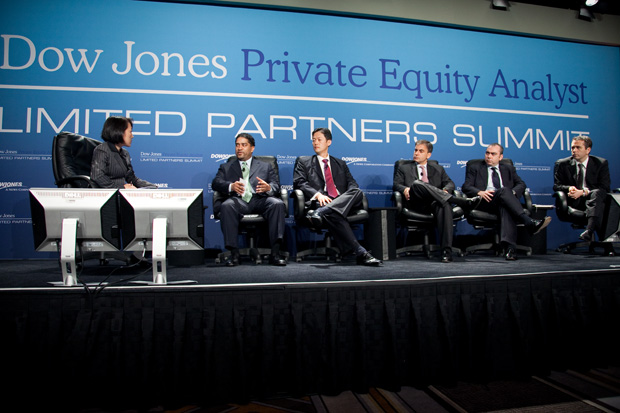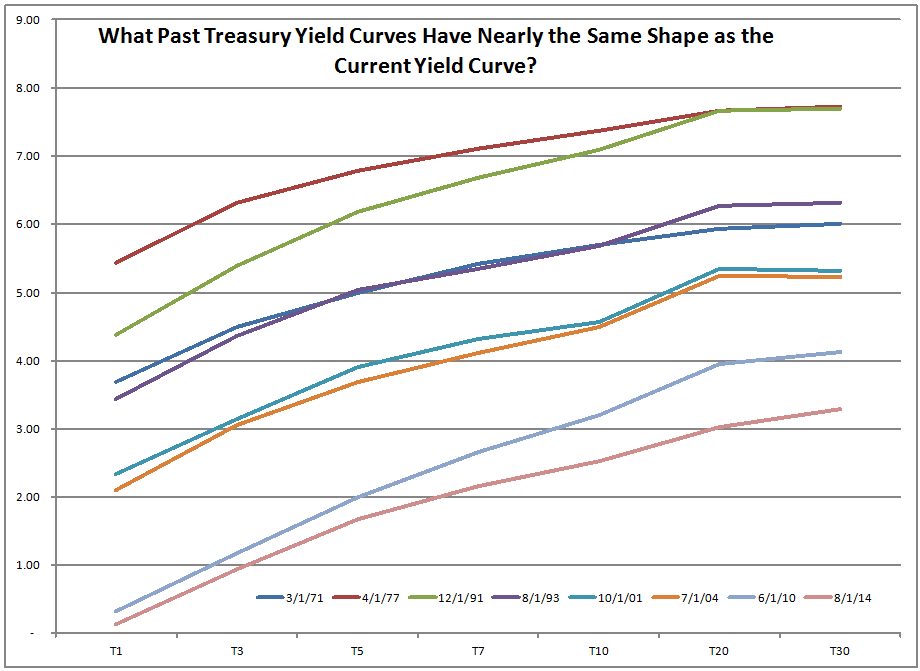
Source: FRED
Above is the chart, and here is the data for tonight’s piece:
| Date |
T1 |
T3 |
T5 |
T7 |
T10 |
T20 |
T30 |
AAA |
BAA |
Spd |
Note |
| 3/1/71 |
3.69 |
4.50 |
5.00 |
5.42 |
5.70 |
5.94 |
6.01* |
7.21 |
8.46 |
1.25 |
High |
| 4/1/77 |
5.44 |
6.31 |
6.79 |
7.11 |
7.37 |
7.67 |
7.73 |
8.04 |
9.07 |
1.03 |
Med |
| 12/1/91 |
4.38 |
5.39 |
6.19 |
6.69 |
7.09 |
7.66 |
7.70 |
8.31 |
9.26 |
0.95 |
Med |
| 8/1/93 |
3.44 |
4.36 |
5.03 |
5.35 |
5.68 |
6.27 |
6.32 |
6.85 |
7.60 |
0.75 |
Med |
| 10/1/01 |
2.33 |
3.14 |
3.91 |
4.31 |
4.57 |
5.34 |
5.32 |
7.03 |
7.91 |
0.88 |
Med |
| 7/1/04 |
2.10 |
3.05 |
3.69 |
4.11 |
4.50 |
5.24 |
5.23 |
5.82 |
6.62 |
0.80 |
Med |
| 6/1/10 |
0.32 |
1.17 |
2.00 |
2.66 |
3.20 |
3.95 |
4.13 |
4.88 |
6.23 |
1.35 |
High |
| 8/1/14 |
0.13 |
0.94 |
1.67 |
2.16 |
2.52 |
3.03 |
3.29 |
4.18 |
4.75 |
0.57 |
Low |
Source: FRED ? ||| ? ? * = Simulated data value ?||| ?Note: T1 means the yield on a one-year Treasury Note, T30, 30-year Treasury Bond, etc.
Above you see the seven yield curves most like the current yield curve, since 1953. ?The table also shows yields for Aaa and Baa bonds (25-30 years in length), and the spread between them.
Tonight’s exercise is to describe the historical environments for these time periods, throw in some color from other markets,?describe what happened afterward, and see if there might be any lessons for us today. ?Let’s go!
March 1971
Fed funds hits a local low point as the FOMC loosens policy under Burns to boost the economy, to fight rising unemployment, so that Richard Nixon could be reassured re-election. ?The S&P 500 was near an all-time high. ?Corporate yield spreads ?were high; maybe the corporate bond market was skeptical.
1971?was a tough year, with the Vietnam War being unpopular.?Inflation was rising, Nixon severed the final link that the US Dollar had to Gold, an Imposed wage and price controls. ?There were two moon landings in 1971 — the US Government was in some ways trying to do too much with too little.
Monetary policy remained loose for most of 1972, tightening late in the years, with the result coming in 1973-4: a severe recession accompanied by high inflation, and a severe bear market. ?I remember the economic news of that era, even though I was a teenager watching Louis Rukeyser on Friday nights with my Mom.
April 1977
Once again, Fed funds is very near its local low point for that cycle, and inflation is rising. ?After the 1975-6 recovery, the stock market is muddling along. ?The post-election period is the only period of time in the Carter presidency where the economy feels decent. ?The corporate bond market is getting close to finishing its spread narrowing after the 1973-4?recession.
The “energy crisis” and the Cold War were in full swing in April 1977. ?Economically, there was no malaise at the time, but in 3 short years, the Fed funds rate would rise from 4.73% to 17.61% in April 1980, as Paul Volcker slammed on the brakes in an effort to contain rising inflation. ?A lotta things weren’t secured and flew through the metaphorical windshield, including the bond market, real GDP,?unemployment, and Carter’s re-election chances. ?Oddly, the stock market did not fall but muddled, with a lot of short-term volatility.
December 1991
This yield curve is the second most like today’s yield curve. ?It comes very near the end of the loosening that the FOMC was doing in order to rescue the banks from all of the bad commercial real estate lending they had done in the late 1980s. ?A wide yield curve would give surviving banks the ability to make profits and heal themselves (sound familiar?). ?Supposedly at the beginning of that process in late 1990, Alan Greenspan said something to the effect of “We’re going to give the banks a lay-up!” ?Thus Fed funds went from 7.3% to 4.4%?in the 12 months prior to December 1991, before settling out at 3% 12 months later. ?Inflation and unemployment were relatively flat.
1991 was a triumphant year in the US, with the Soviet Union falling, Gulf War I ending in a victory (though with an uncertain future), 30-year bond yields hitting new lows, and the stock market hitting new all time highs. ?Corporate bonds were doing well also, with tightening spreads.
What would the future bring? ?The next section will tell you.
August 1993
This yield curve is the most like today’s yield curve. ?Fed funds are in the 13th month out of 19 where they have been held there amid a strengthening economy. ?The housing market is?doing well, and mortgage refinancing has been high for the last three years, creating a situation where those investing in mortgages securities have a limited set of coupon rates that they can buy if they want to put money to work in size.
An aside before I go on — 1989 through 1993 was the era of clever mortgage bond managers, as CMOs sliced and diced bundles of mortgage payments so that managers could make exotic bets on moves in interest and prepayment rates. ?Prior to 1994, it seemed the more risk you took, the better returns were. ?The models that most used were crude, but they thought they had sophisticated models. ?The 1990s were an era where prepayment occurred at lower and lower thresholds of interest rate savings.
As short rates stayed low, long bonds rallied for two reasons: mortgage bond managers would hedge their portfolios by buying Treasuries as prepayments occurred. ?They did that to try to maintain a constant degree of interest rate sensitivity to overall moves in interest rates. ?Second, when you hold down short rates long enough, and you give the impression that they will stay there (extended period language was used — though no FOMC Statements were made prior to 1994), bond managers start to speculate by buying longer securities in an effort to clip extra income. ?(This is the era that this story (number 2 in this article) took place in, which is part of how the era affected me.)
At the time, nothing felt too unusual. ?The economy was growing, inflation was tame, unemployment was flat. ?But six months later came the comeuppance in the bond market, which had some knock-on effects to the economy, but primarily was just a bond market issue. ? The FOMC hiked the Fed funds rate in February 1994 by one?quarter percent, together with a novel statement issued by Chairman Greenspan. ?The bond market was caught by surprise, and as rates rose, prepayments fell. ?To maintain a neutral market posture, mortgage bond managers sold long Treasury and mortgage bonds, forcing long rates still higher. ?In the midst of this the FOMC began raising the fed funds rate higher and higher as they feared economic growth would lead to inflation, with rising long rates a possible sign of higher expected inflation. ?The FOMC raises Fed fund by 1/2%.
In April, thinking they see continued rises in inflation expectation, they do an inter-meeting surprise 1/4% raise of Fed funds, followed by another 1/2% in May. ?It is at this pint that Vice Chairman McDonough tentatively realizes?[page 27] that the mortgage market has?now tightly coupled the response of the long end of the bond market to the short end the bond market, and thus, Fed policy. ?This was never mentioned again in the FOMC Transcripts, though it was the dominant factor moving the bond markets. ?The Fed was so focused on the real economy, that they did not realize their actions were mostly affecting the financial economy.
FOMC policy continued: Nothing in July, 1/2% rise in August, nothing in September, 3/4% rise in November, nothing in December, and 1/2% rise in February 1995, ending the tightening. In late December 1994 and January of 1995, the US Treasury and the Fed participated in a rescue of the Mexican peso, which was mostly caused by bad Mexican economic policy, but higher rates in the US diminished demand for the cetes, short-term US Dollar-denominated Mexican government?notes.
The stock market muddled during this period, and the real economy kept growing, inflation in check, and unemployment unaffected. ?Corporate spreads tightened; I remember that it was difficult to get good yields for my Guaranteed Investment Contract [GIC] business back then.
But the bond markets left their own impacts: many seemingly clever mortgage bond managers blew up, as did the finances of Orange County, whose Treasurer was a mortgage bond speculator. ?Certain interest rate derivatives blew up, such as the ones at Procter & Gamble. ?Several life insurers lost a bundle in the floating rate GIC market; the company I served was not one of them. ?We even made extra money that year.
The main point of August 1993 is this: holding short rates low for an extended period builds up imbalances in some part of the financial sector — in this case, it was residential mortgages. ?There are costs to providing too much liquidity, but the FOMC is not an institution with foresight, and I don’t think they learn, either.
This has already gotten too long, so I will close up here, and do part II tomorrow. ?Thanks for reading.






